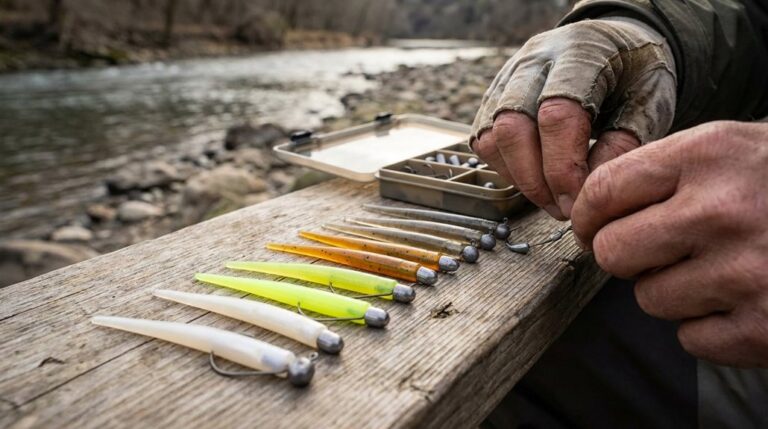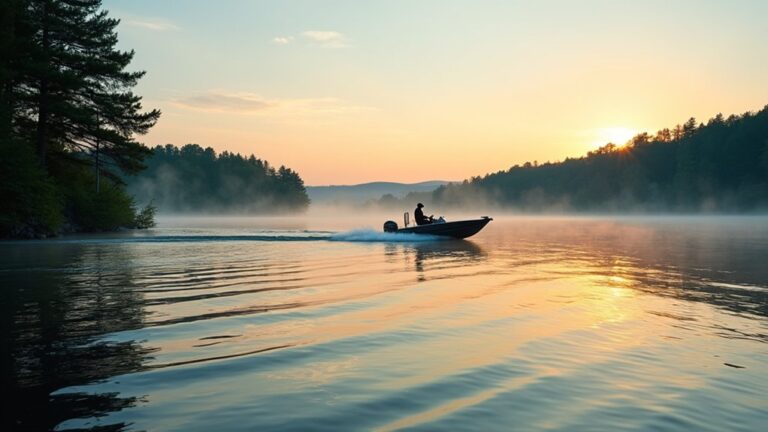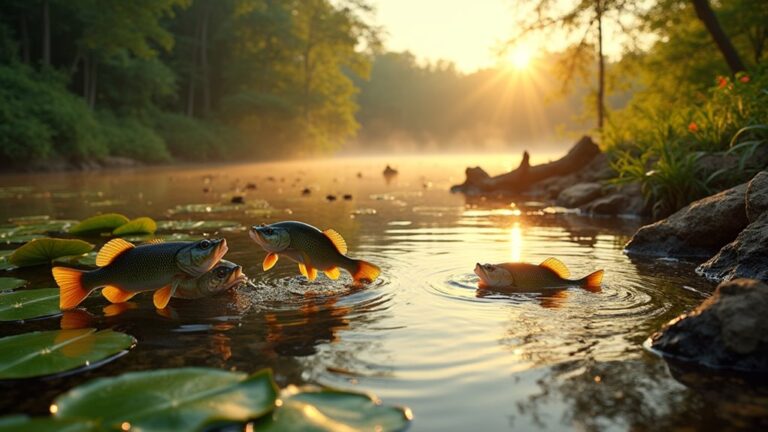To get started fishing, you'll need some crucial gear, like a spinning rod and reel, fishing line, and a tackle box filled with hooks, sinkers, and bait. First, grab a fishing license; it's often inexpensive and can be obtained online or in stores. Next, choose a good fishing spot—local lakes and rivers are perfect for beginners. Master basic techniques like casting and setting the hook. Don't forget to fish ethically by following local regulations and practicing catch and release. As you gear up, you'll uncover even more tips and tricks to enhance your fishing adventures!
Key Takeaways
- Obtain a fishing license, which is often required and can be purchased online or at local stores.
- Invest in essential gear like a spinning rod and tackle box with hooks, sinkers, and bait.
- Choose beginner-friendly fishing spots such as local lakes or ponds, preferably during early mornings or late evenings.
- Learn basic fishing techniques including casting, hook setting, and safely landing fish to improve your skills.
- Familiarize yourself with local regulations and practice ethical fishing to support conservation efforts and maintain fish populations.
Understanding Fishing Basics
Understanding the basics of fishing is fundamental for any aspiring angler. First, you'll need to get a fishing license, which most states require. These licenses typically cost under $20 for a day or between $30 to $150 for an annual pass, depending on where you live.
Once you have your license, you can start gathering your indispensable gear. A spinning rod and reel combo is perfect for beginners, along with fishing line that has a weight of 4 to 12 pounds. Don't forget to stock your tackle box with basic tackle like hooks, sinkers, and bobbers.
Next, familiarize yourself with local fishing regulations. Knowing catch limits and permissible bait types is critical for responsible fishing and conservation. Different fish species have unique habits, so understanding them will improve your chances of success.
When it comes to casting techniques, aim for smooth arm movements and proper wrist action. Release the line at the right moment to achieve distance and accuracy.
Essential Fishing Gear
Having the right fishing gear can make all the difference in your experience on the water. For beginners, a basic setup includes a spinning rod and reel combo, as it's user-friendly and effective. You'll also want to choose the right fishing line; monofilament in the 4-12 pound range works well for most species.
To guarantee you're prepared, consider adding these crucial items to your tackle box:
- Hooks (size 6-10)
- Sinkers
- Bobbers for bite indication
- Live bait like worms or minnows
- Artificial lures for versatility
Having a good selection of fishing tackle will improve your chances of success. Don't forget the needle-nose pliers for easy hook removal, and a rubber net for safely landing your catch.
These tools not only enhance your fishing experience but also help protect the fish you plan to release.
With the right gear in hand, you'll be well on your way to enjoying your time on the water, whether you're casting from the shore or out on a boat.
Happy fishing!
Getting Your Fishing License
Before you head out to enjoy your new fishing gear, it's important to make certain you're fishing legally by obtaining a current fishing license specific to your state. You can purchase your fishing license online, at a local tackle shop, or even at convenience stores.
Licensing costs vary, with day licenses typically under $20 and annual licenses ranging from $30 to $150, depending on your residency and state fishing regulations. If you're under 16, many states offer free fishing licenses, giving young anglers a fantastic start!
While you're at it, familiarize yourself with local fishing regulations, including catch limits and bait restrictions. These details are often provided with your license purchase or found in local regulation books.
| License Type | Cost | Notes |
|---|---|---|
| Day License | Typically < $20 | Perfect for beginners |
| Annual License | $30 – $150 | Great for regular anglers |
| Free License | For under 16 | Encourages youth fishing |
| Up-to-date License | Necessary | Avoids hefty fines |
| License Info | Available online | Quick and easy access |
Always make certain your license is up-to-date and with you while fishing!
Choosing the Right Fishing Spot
Choosing the right fishing spot can make all the difference in your experience and success. Start by looking for local lakes, ponds, or rivers that are known to host beginner-friendly fish species like bluegill, panfish, and bass.
Here are some tips to help you choose the best spot:
- Use the Fishbrain app or local fishing reports to find popular fishing spots and current conditions.
- Make sure the location has public access to avoid any legal issues.
- Check local regulations to understand fishing limits and allowed fishing methods.
- Consider timing; early mornings and late evenings are typically the best times to fish.
- Explore small, less crowded bodies of water to enhance your chances of success.
Basic Fishing Techniques
Once you've found the perfect fishing spot, it's time to focus on basic fishing techniques that will boost your chances of landing a catch. Start by mastering your casting technique. Hold the rod with the reel below your dominant hand, flip the bail open, and cast forward smoothly, like throwing a baseball.
Once you feel a tug or see your bobber moving, it's time for hook setting. Quickly raise the rod tip to guarantee the hook penetrates the fish's mouth while maintaining moderate pressure.
After setting the hook, you'll be playing the fish. Keep the rod tip up and maintain tension on the line to tire it out, which makes reeling it in easier.
When the fish is close, it's time for landing the fish. Use a rubber net to scoop it up gently, avoiding contact with its gills to guarantee its survival if you plan to release it.
Lastly, remember to always be practicing safety. Cast in open areas away from others, and wear a life jacket if you're on a boat.
| Technique | Description |
|---|---|
| Casting Technique | Smoothly cast like throwing a baseball |
| Hook Setting | Raise rod tip quickly when feeling a tug |
| Landing the Fish | Use a rubber net to scoop without squeezing |
Selecting Bait and Lures
Selecting the right bait and lures is vital for a successful fishing trip. Whether you're freshwater fishing or targeting specific species, your choice can make all the difference. Here are some fishing tips to take into account:
- Live Bait: Worms, minnows, and insects attract fish due to their natural scent and movement.
- Artificial Lures: Jigs, spinners, and crankbaits mimic prey and can be effective in various environments.
- Target Species: Tailor your bait selection; for instance, crickets are great for bluegill, while earthworms work well for bass.
- Scented Baits: These can enhance effectiveness, especially in murky waters where visibility is low.
- Rigging: Properly rigging your bait and lures is imperative. Make sure hooks are securely attached and that the bait is presented attractively.
Conservation and Ethical Practices
Fishing isn't just about the thrill of the catch; it's also about the responsibility that comes with it. To guarantee a healthy ecosystem, you need to familiarize yourself with local fishing regulations, including size and bag limits.
Following these fishing rules promotes compliance and supports sustainable fishing practices, helping maintain fish populations for future generations.
Practicing catch and release techniques is crucial. By allowing undersized or unwanted fish to survive and reproduce, you contribute to an ecosystem's balance.
When handling fish, use tools like dehookers and wet hands to minimize stress and injury, increasing their chances of survival upon release.
Cleaning up after yourself is another important aspect. Properly disposing of trash prevents pollution and protects aquatic habitats, leading to healthier ecosystems.
Additionally, be mindful of invasive species. Always clean your gear and equipment before moving between bodies of water to help preserve local biodiversity.
Safety Tips for Anglers
Safety should always be your top priority when you're out on the water. Whether you're fishing from a boat or the shore, being aware of potential hazards can make your experience enjoyable and safe. Here are some crucial safety tips to keep in mind:
- Wear a properly fitted life jacket to reduce the risk of drowning, especially on unstable surfaces.
- Apply high-SPF sunscreen and reapply often to protect your skin from sunburn during long hours outside.
- Stay hydrated by drinking plenty of water; dehydration can sneak up on you in sunny or windy conditions.
- Use polarized sunglasses to cut down on glare, helping you spot fish and hazards more clearly.
- Check local weather conditions before you head out and avoid fishing during severe weather, like thunderstorms, which can pose serious safety risks.
Also, don't forget to carry your fishing licenses, as they're often required for compliance.
Resources for Learning More
Once you've got the basics of safety in mind, it's time to enhance your fishing skills and knowledge.
You'll need reliable resources to help you learn how to start. Websites like TakeMeFishing.org and your local department's website, such as TPWD, offer thorough guides on fishing equipment for beginners, local fishing regulations, and even places to fish.
Don't overlook mobile apps like Fishbrain and Texas Outdoor Annual. These can assist you in finding the best spots while managing your fishing license, plus they provide real-time updates on regulations.
YouTube is another great option. Watching instructional videos can show you crucial techniques, gear assembly, and casting methods, giving you visual guidance as you practice.
Participating in local fishing clinics and workshops is an excellent way to gain hands-on experience while networking with seasoned anglers.
Lastly, consider reading books or e-books like the "Everything You Need To Start Fishing Quick Guide." These materials provide foundational knowledge and tips that can help make your fishing outings successful.
With these resources for learning more, you'll be well on your way to becoming a confident angler.
Conclusion
Now that you've got the basics down, it's time to hit the water and enjoy the thrill of fishing. Did you know that nearly 50 million Americans go fishing each year? With the right gear, techniques, and a little patience, you'll be joining their ranks in no time. Remember to practice conservation and safety, and you'll not only enhance your experience but also help preserve our waterways for future generations. Happy fishing!



